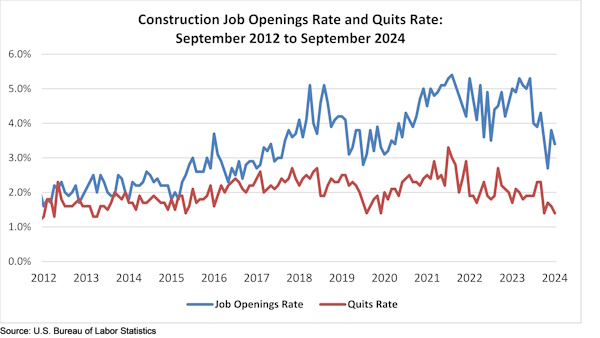Is the 2024 labor market in construction strong? Has work slowed to a grinding halt? What is the outlook for 2025 and beyond? Is there a shortage of labor? Are young workers curious about construction or shying away from it? All these questions are weighing heavily on top of the minds of many construction company executives today.
Despite all the hype, ABC (Associated Builders and Contractors) is sounding the alarm bells because construction is plummeting and sadly this shouldn’t be happening when it’s an industry that should be ripe with opportunity. Let’s look at some of the recent numbers from a few different surveys and studies that point to labor trends in the construction industry.
The State of Construction Jobs
The U.S. Bureau of Labor Statistics’ Job Openings and Labor Turnover Survey shows us the construction industry had 288,000 job openings on the last day of September. Industry job openings decreased by 40,000 that month and are down by 134,000 from the same time last year. This is a 32% decline in construction job opening in the past year. Has work slowed to a grinding halt?


Looking specifically at September’s numbers, ABC Chief Economist Anirban Basu says Hurricane Helene temporarily suppressed the number of open construction positions across the Southeast. Still, according to ABC’s Construction Confidence Index, roughly 45% of contractors intend to increase their staffing levels in the next six months.
Construction Labor Trends Today
The construction labor discuss is layered, deeply complex, and multifaceted, but there are some key points to note, such as the recent study that indicates 70% of site workers and 85% of office workers in this sector report feeling stressed at work, significantly impacting both their professional performance and personal lives.
This research comes from researchers at the University of Cambridge, and it shines a bright light on the mental health concerns in the construction industry workforce. This qualitative study investigates stress experiences and the management of stress in office-based and on-site workers in the U.K. building construction sector.
The study identified two major themes:
- the negative influence of work stress on personal and professional wellbeing,
- and the management of stress through proactive and reactive coping strategies.
Results indicated on-site workers frequently cited high workloads, tight deadlines, and safety concerns, whereas office-based workers tended to highlight job complexity and organizational pressures. Both groups agree stress impacts their work performance.
How do they cope? Many tend to rely on support networks, outside-the-workplace hobbies, and boundary-setting, among others. Internal and external support systems are key here. The literature has shown the importance that social support has when it comes to stress, and overall mental health. In fact, researchers from Yale University School of Medicine and Mount Sinai School of Medicine suggest social support can help people bounce back from stress.
The bottomline is this: stress remains a significant problem in the construction workplace and affects wellbeing. However, there are some things that can help including, but not limited to,
- Programs to mitigate stress and promote wellbeing
- Environmental conditions
- Safety programs
- Organizational cultures
- Other innovative programs to improve overall worker wellbeing

From where you are sitting, what is your perspective of the construction labor trends? Has work slowed to a grinding halt? Is there a shortage of labor? Are young workers curious about construction or shying away from it? I would love to hear from you! What are you seeing on your own jobsites?
Want to tweet about this article? Use hashtags #construction #IoT #sustainability #AI #5G #cloud #edge #futureofwork #infrastructure #labor #worker


